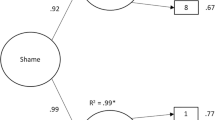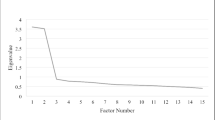Abstract
The study aimed to explain adaptive and maladaptive functioning of shame and guilt using discomfort intolerance as a moderator. Sample comprised of 387 adolescents and young adults (51.7% females) age ranged 15–20 years. Data were collected using Frustration Discomfort Scale, Test of Self-Conscious Affect, and Youth Self-Report. Bivariate correlations showed that for the first quartile of discomfort intolerance, shame positively correlated and guilt negatively correlated with psychopathologies, whereas for the last quartile of discomfort intolerance, shame negatively correlated and guilt positively correlated with psychopathologies. Multiple linear regression analysis showed that discomfort intolerance moderates effect of both shame and guilt on internalizing problems and externalizing problems. It is concluded that shame and guilt have both adaptive and maladaptive functioning. The conditional effect of discomfort intolerance distinguishes the patterns of relationship between shame and guilt and psychopathology.


Similar content being viewed by others
References
Achenbach, T. M. (1991). Manual for the youth self-report and 1991 profile. Burlington: Department of Psychiatry, University of Vermont.
Alexander, B., Brewin, C. R., Vearnals, S., Wolff, G., & Leff, J. (1999). An investigation of shame and guilt in a depressed sample. British Journal of Medical Psychology, 72(Pt 3), 323–338.
Allan, S., Gilbert, P., & Goss, K. (1994). An exploration of shame measures—II: Psychopathology. Personality and Individual Differences, 17(5), 719–722.
Andrews, B., & Hunter, E. (1997). Shame, early abuse, and course of depression in a clinical sample: A preliminary study. Cognition and Emotion, 11(4), 373–381.
Barr, P. (2004). Guilt- and shame-proneness and the grief of perinatal bereavement. Psychology and Psychotherapy, 77(Pt 4), 493–510.
Barrett, K. C. (1995). A functionalist approach to shame and guilt. In J. P. Tangney & K. W. Fischer (Eds.), Self-conscious emotions: The psychology of shame, guilt, embarrassment, and pride (pp. 25–63). New York: Guilford Press.
Bryan, C. J., Morrow, C. E., Etienne, N., & Ray-Sannerud, B. (2013). Guilt, shame, and suicidal ideation in a military outpatient clinical sample. Depression and Anxiety, 30(1), 55–60.
Burney, J., & Irwin, H. J. (2000). Shame and guilt in women with eating-disorder symptomatology. Journal of Clinical Psychology, 56(1), 51–61.
Campos, J. J., Mumme, D. L., Kermoian, R., & Campos, R. G. (1994). A functionalist perspective on the nature of emotion. Monographs of the Society for Research in Child Development, 59(2–3), 284–303.
Cole, P. M., Michel, M. K., & Teti, L. O. D. (1994). The development of emotion regulation and dysregulation: A clinical perspective. Monographs of the Society for Research in Child Development, 59(2–3), 73–102.
Gilbert, D. T., & Ebert, J. E. (2002). Decisions and revisions: The affective forecasting of changeable outcomes. Journal of Personality and Social Psychology, 82(4), 503–514.
Haidt, J., & Keltner, D. (1999). Culture and facial expression: Open-ended methods find more expressions and a gradient of recognition. Cognition and Emotion, 13(3), 225–266.
Harrington, N. (2005). The Frustration Discomfort Scale: Development and psychometric properties. Clinical Psychology and Psychotherapy, 12, 374–387.
Irwin, H. J. (1998). Affective predictors of dissociation. II: Shame and guilt. Journal of Clinical Psychology, 54(2), 237–245.
Jibeen, T. (2013). Frustration intolerance beliefs as predictors of emotional problems in university undergraduates. Journal of Rational-Emotive & Cognitive-Behavior Therapy, 31(1), 16–26.
Kline, P. (2000). The handbook of psychological testing (2nd ed.). London: Routledge.
Kugler, K., & Jones, W. H. (1992). On conceptualizing and assessing guilt. Journal of Personality and Social Psychology, 62(2), 318–327.
Leadbeater, B. J., Kuperminc, G. P., Blatt, S. J., & Hertzog, C. (1999). A multivariate model of gender differences in adolescents’ internalizing and externalizing problems. Developmental Psychology, 35(5), 1268–1282.
Lewis, H. B. E. (1987). The role of shame in symptom formation. Mahwah: Lawrence Erlbaum Associates Inc.
Luyten, P., Fontaine, J. R., & Corveleyn, J. (2002). Does the test of self-conscious affect (TOSCA) measure maladaptive aspects of guilt and adaptive aspects of shame? An empirical investigation. Personality and Individual Differences, 33(8), 1373–1387.
Morrison, A. P. (1989). Shame: The underside of narcissism. New York: Taylor & Francis.
Stuewig, J., & McCloskey, L. A. (2005). The relation of child maltreatment to shame and guilt among adolescents: Psychological routes to depression and delinquency. Child Maltreatment, 10(4), 324–336.
Tangney, J. P. (1990). Assessing individual differences in proneness to shame and guilt: Development of the self-conscious affect and attribution inventory. Journal of Personality and Social Psychology, 59(1), 102–111.
Tangney, J. P. (1991). Moral affect: The good, the bad, and the ugly. Journal of Personality and Social Psychology, 61, 598–607.
Tangney, J. P. (1992). Situational detenninants of shame and guilt in young adulthood. Personality and Social Psychology Bulletin, 18(2), 199–206.
Tangney, J. P. (1996). Conceptual and methodological issues in the assessment of shame and guilt. Behaviour Research and Therapy, 34(9), 741–754.
Tangney, J. P., & Dearing, R. L. (2002). Shame and guilt. New York: Guilford Press.
Tangney, J. P., Miller, R. S., Flicker, L., & Barlow, D. H. (1996a). Are shame, guilt, and embarrassment distinct emotions? Journal of Personality and Social Psychology, 70(6), 1256–1269.
Tangney, J. P., Stuewig, J., & Hafez, L. (2011a). Shame, guilt and remorse: Implications for offender populations. Journal of Forensic Psychiatry and Psychology, 22(5), 706–723.
Tangney, J. P., Stuewig, J., & Martinez, A. G. (2014). Two faces of shame: The roles of shame and guilt in predicting recidivism. Psychological Science, 25(3), 799–805.
Tangney, J. P., Stuewig, J., Mashek, D., & Hastings, M. (2011b). Assessing jail inmates’ proneness to shame and guilt: Feeling bad about the behavior or the self? Criminal Justice and Behavior, 38(7), 710–734.
Tangney, J. P., Wagner, P., Fletcher, C., & Gramzow, R. (1992a). Shamed into anger? The relation of shame and guilt to anger and self-reported aggression. Journal of Personality and Social Psychology, 62(4), 669–675.
Tangney, J. P., Wagner, P., & Gramzow, R. (1992b). Proneness to shame, proneness to guilt, and psychopathology. Journal of Abnormal Psychology, 101(3), 469–478.
Tangney, J. P., Wagner, P. E., Hill-Barlow, D., Marschall, D. E., & Gramzow, R. (1996b). Relation of shame and guilt to constructive versus destructive responses to anger across the lifespan. Journal of Personality and Social Psychology, 70(4), 797–809.
Ten Klooster, P. M., Christenhusz, L. C., Taal, E., Eggelmeijer, F., van Woerkom, J. M., & Rasker, J. J. (2014). Feelings of guilt and shame in patients with rheumatoid arthritis. Clinical Rheumatology, 33(7), 903–910.
Teroni, F., & Deonna, J. A. (2008). Differentiating shame from guilt. Consciousness and Cognition, 17(3), 725–740.
Tracy, J. L., & Robins, R. W. (2004). Putting the self into self-conscious emotions: A theoretical model. Psychological Inquiry, 15(2), 103–125.
VanDerhei, S., Rojahn, J., Stuewig, J., & McKnight, P. E. (2014). The effect of shame-proneness, guilt-proneness, and internalizing tendencies on nonsuicidal self-injury. Suicide and Life-Threatening Behavior, 44(3), 317–330.
Verhulst, F. C., van der Ende, J., & Koot, H. M. (1997). Manual for the youth self-report (YSR). Rotterdam, The Netherlands: Erasmus University, Department of Child and Adolescent Psychiatry, Sophia Children’s Hospital.
Webb, M., Heisler, D., Call, S., Chickering, S. A., & Colburn, T. A. (2007). Shame, guilt, symptoms of depression, and reported history of psychological maltreatment. Child Abuse and Neglect, 31(11–12), 1143–1153.
Werkander, H. C., Roxberg, A., Andershed, B., & Brunt, D. (2012). Guilt and shame—a semantic concept analysis of two concepts related to palliative care. Scandinavian Journal of Caring Sciences, 26(4), 787–795.
Wong, Y., & Tsai, J. (2007). Cultural models of shame and guilt. In J. L. Tracy, R. W. Robins, & J. P. Tangney (Eds.), The self-conscious emotions: Theory and research (pp. 209–223). London: The Guilford Press.
Author information
Authors and Affiliations
Corresponding author
Rights and permissions
About this article
Cite this article
Taihara, Q., Malik, J.A. Is It Adaptive or Maladaptive? Elaborating Conditional Role of Shame and Guilt in Development of Psychopathologies. Psychol Stud 61, 331–339 (2016). https://doi.org/10.1007/s12646-016-0381-7
Received:
Accepted:
Published:
Issue Date:
DOI: https://doi.org/10.1007/s12646-016-0381-7




